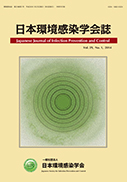
- Issue 5 Pages 220-
- Issue 4 Pages 149-
- Issue 3 Pages 75-
- Issue 2 Pages 41-
- Issue 1 Pages 1-
- |<
- <
- 1
- >
- >|
-
Nobue SHIMANAKA, Kazumi KAWAKAMI, Kenichi SAKAMOTO, Koh OKAMOTO, Yumi ...2023 Volume 38 Issue 5 Pages 220-228
Published: September 25, 2023
Released on J-STAGE: March 25, 2024
JOURNAL FREE ACCESSHand hygiene in health care has been evolving globally over the last few decades. It has been more than 10 years since WHO published its guideline on hand hygiene in 2009, and progress has been made in Japan. This narrative review illustrates local activities conducted by a team "Train the Trainers in Hand Hygiene - Japan" and future directions for further hand hygiene promotion.
View full abstractDownload PDF (579K)
-
Masamichi OGURA, Satomi ASAI, Kazuo UMEZAWA, Toshio OHSHIMA, Toshiki K ...2023 Volume 38 Issue 5 Pages 229-234
Published: September 25, 2023
Released on J-STAGE: March 25, 2024
JOURNAL FREE ACCESSThis study aimed to develop appropriate measures against drug-resistant bacteria for elderly people living in long-term care facilities. The stool samples of facilities A-C were analyzed via a survey on extended-spectrum beta-lactamase (ESBL) -producing bacteria carriage. Factors related to carriage, user characteristics, and facility characteristics were also analyzed. The results showed that the detection rate of ESBL-producing bacteria was significantly higher in the antibacterial drug administration group (detection rate ratio of 12.71 [95%CI: 1.33-121.53]), indicating a relationship between ESBL-producing bacteria carriage and antibiotics usage history. Moreover, the detection rate was highest (36.7%) in elderly living in unit-type (private room) facility (facility B) with the lowest degree of care. The detection rate was lowest (5.9%) in the conventional (multi-bed room type) facility (facility C) with a high level of nursing care. The key difference between the two facilities was that some users were prescribed antibiotics daily in facility B while no antibiotics were prescribed at all in facility C. It was once thought that nursing homes for the elderly play a major role in spreading drug-resistant bacteria. However, the results of this study suggest that the risk of drug-resistant bacteria carriage varies greatly depending on the frequency of antibiotics prescription.
View full abstractDownload PDF (375K)
-
Keisuke YONEMURA2023 Volume 38 Issue 5 Pages 235-240
Published: September 25, 2023
Released on J-STAGE: March 25, 2024
JOURNAL FREE ACCESSSerum SARS-CoV-2 S-IgG antibody of 383 hospital staff was measured approximately 6 months after the second vaccination (stage I-II) and approximately 5 months after the third vaccination (Stage III), to clarify factors associated with serum antibody titers acquired by mRNA vaccines against novel coronavirus (SARS-CoV-2). Several statistical analyses were performed on the relationships between background factors and serum antibody titers in 266 cases with no history of infection. In univariate analysis, factors affecting stage I-II antibody titers were age, blood type, underlying disease, pollen allergy, postvaccination side effects, exercise habits, snacking habits, and poor antibody production with other vaccines. Pollen allergy, postvaccination side effects, and poor antibody production with other vaccines were also associated with stage III antibody titers. In multivariate analysis, factors affecting stage I-II antibody titers were age, blood type, fever, snacking habits, and poor antibody production with other vaccines. In addition, factors affecting stage III antibody titers were gender, pollen allergy, and poor antibody production to other vaccines. Though the antibody titers of high-risk groups were lower than low-risk groups in the second vaccination, they became equivalent after the third vaccination. It means that third vaccination produced sufficient antibodies even in high-risk groups, and it contributes greatly to the prevention of aggravation.
View full abstractDownload PDF (328K)
-
Hideaki KATO2023 Volume 38 Issue 5 Pages 241-244
Published: September 25, 2023
Released on J-STAGE: March 25, 2024
JOURNAL FREE ACCESSAmid novel coronavirus disease (COVID-19) pandemic, choral activities are considered as the activities with the highest risk of spreading infection. Wearing masks on stage is an effective infection control measure; however, it has the disadvantage of making it difficult to sing and reducing the quality of music. We conducted a 12-song, 90-minute choral concert with 24 on-stage singers during the epidemic period in January 2023, with a quantitative rapid antigen test negative on the day of the concert, ensuring social distance on stage, and performing without masks. PCR test was conducted 1 week after the event; only one person was positive for PCR testing. Even during the Omicron strain epidemic, which has a short incubation period, it was considered possible to hold a choral concert without masks by utilizing a quantitative antigen test before the concert.
View full abstractDownload PDF (258K)
-
Yoshinori KATAYAMA, Hidetoshi NARUMI2023 Volume 38 Issue 5 Pages 245-249
Published: September 25, 2023
Released on J-STAGE: March 25, 2024
JOURNAL FREE ACCESSWe experienced a case of hospital-acquired infection of SARS-CoV-2 from a healthcare worker working in the neonatal intensive care unit (NICU) to a neonate, and we report it because there is no similar case in Japan in the literature. The case was a premature infant born at 35 weeks of gestation, and the nurse in charge developed a sore throat the day after work, and 3 days later, a positive SARS-CoV-2 test was confirmed. SARS-CoV-2 was also detected in the infant on the same day (age, 19 days) in a nucleic acid test. As the infant was kept in a private room in the NICU, no symptoms were observed. If healthcare workers working in neonatal wards are contracted with COVID-19, the status of contact with the neonates should be checked in detail. Nosocomial infection control measures for the contact infants, such as isolation and active testing are necessary if it is determined that they fall under the definition of a close contact.
View full abstractDownload PDF (285K)
- |<
- <
- 1
- >
- >|